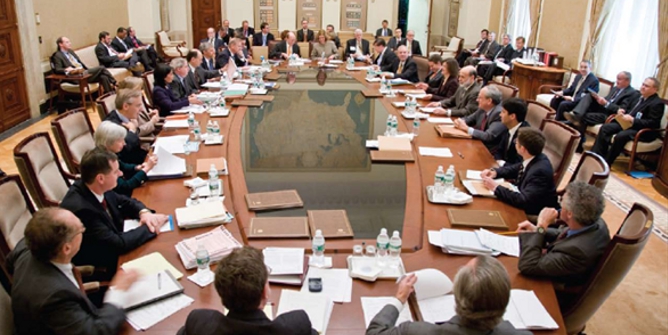In a newly expanded version of their book, The Bankers’ New Clothes, Anat Admati and Martin Hellwig demystify banking and expose how current financial regulatory practices enrich bankers while increasing the risk of economic crises and undermining democracy. Admati and Hellwig’s call for reform to boost stability, specifically through higher equity requirements for banks, is more urgent and persuasive than ever, writes Hans G Despain.
Anat Admati spoke about the new edition at a public LSE event in May. Watch it back on YouTube.
 Banking and high finance have a certain mystique. An all-too-common view is these industries are too difficult and complex for mere mortals to understand; consequently, so the argument goes, regulations should be left to the financial experts.
Banking and high finance have a certain mystique. An all-too-common view is these industries are too difficult and complex for mere mortals to understand; consequently, so the argument goes, regulations should be left to the financial experts.
In their book The Bankers’ New Clothes: What’s Wrong with Banking and What to Do about It, Anat Admati and Martin Hellwig aim to demystify banking and high finance in a language accessible to the general public. They contend that this hegemonic Orwellian attitude of “leave it to the experts” enriches bankers but endangers society by generating financial crises and economic recessions, and poses a fundamental threat to the order of law and democracy itself.
The new edition is really three books in one. First is their original argument initially published in 2013 in thirteen chapters, 228 pages. Second is their expanded and updated section of four new chapters, 123 pages. Third is their endnotes of 173 pages. In their original and expanded editions Admati and Hellwig brilliantly make the details of banking and finance accessible to a general audience. Their endnotes provide more esoteric insights and citations for experts.
It is disturbing that the original 2013 argument is still relevant and topical. Unfortunately, it is even more urgent.
It is disturbing that the original 2013 argument is still relevant and topical. Unfortunately, it is even more urgent. The primary message of book is that banks should be required to have more equity.
Admati and Hellwig point out that non-financial corporations typically invest with equity levels of 20 per cent or much more. If they didn’t have at least 20 per cent equity, banks would see a non-financial firm as too risky of a borrower (105-7). Historically, financial firms hold 25 per cent or more in equity. If the value of the financial firm’s investments decline, the losses would be borne by stock-holders/owners of the financial firm. In this case, investment losses would have no adverse affect on the bank’s ability to repay its depositors or for the financial firm to repay its creditors, until the investment losses are more than the financial firm’s equity.
Admati and Hellwig underscore the fact that the equity that financial firms use has fallen precipitously in the last six decades. Today the equity requirement of financial firms is a dangerously low three per cent, and legal accounting loopholes allow financial firms to even even lower (85-7 & 251-8).
the US and global financial systems are too fragile primarily because of a lack of a proper equity requirement
They argue that the US and global financial systems are too fragile primarily because of a lack of a proper equity requirement (6-8). The lack of a proper equity requirement (20-30 per cent) is due to the financial industry being both underregulated and mis-regulated (233-8). The under- and mis-regulation is generated by “regulatory capture” (203-7; 327-334) and fallacious understanding of how financial systems operate.
According to Admati and Hellwig, the fallacious understanding is either ignorance (ixxvi), purposeful obtuseness (314, 508n9), or wilful blindness (248, 253). Bad theories and arguments buffer the financial industries against proper regulations. In Hans Christian Anderson’s fairy tale of the Emperor’s New Clothes, the new clothes are a fallacy: the emperor is naked. In the same way, banks are naked without proper regulations.
Much of The New Bankers’ Clothes is aimed at debunking flawed claims of the finance industries and their enablers. However, the debunking has not deterred the bankers, lobbyists, policymakers, academics, and others from continuing to make these flawed claims and invent new ones.
Flawed claims still dominate financial policy discussion. What is so insidious about these them is that many of their supporters do not care whether they are true
Flawed claims still dominate financial policy discussion. What is so insidious about these them is that many of their supporters do not care whether they are true, but employ them strategically in order to gain the allegiance of policy makers and the general public to win the legislative debates regarding bank regulation.
Admati and Hellwig have created a document called “The Parade of the Bankers’ New Clothes Continues: 44 Flawed Claims Debunked” that summarises the flawed claims of bankers and their enablers that they continuously edit and update.
The claims help manifest the under- and mis-regulation of the industry. In turn, the flawed claims expose the public to unnecessary risks, financial instability and economic crises (145-7). The financial system fails to support the mainstream economy as well as it should (148-66, 231-67) and distorts the economic actions of participants (142-5), generating massive moral hazards, problems (122-7) and perverse incentives (324-30).
This fragility is made particularly dangerous due to the interconnectedness of the global finance system on the one hand (60-78), and the interconnectedness of finance with industry and society on the other (208-28). The fragility comes from the fact banking is necessarily dependent on short-term deposits and short-term debt as its liabilities and looks for revenue by making long-term loans and investments.
Additionally, the under-regulation allows financial institutions to be highly leveraged, ie, banks invest not with their money, but with other people’s borrowed money (208-28). The reason why a bank, or anyone, would invest with high leverage is because it magnifies the returns on investment. But remember, leverage also magnifies losses.
The deep systemic indebtedness of the financial system means that gains and losses are magnified for individual banks. The interconnectedness of the banks means that magnified losses of a few banks can be contagious ( 60-65). Like apples in a barrel, one bad bank can rot all the other banks in the system.
Today banks are bigger and more powerful than they were in 2013 but “are still too highly indebted, and many of them are too large, too complex, and too opaque” (237). Wherefore, the system is still too fragile, liable to systemic crises, hence dangerous for society.
In 2010, Obama promised: ‘No more bailouts. Period’. Nonetheless, bailouts have continued as a matter of course. In the last seven decades there are endless examples of central bank supports and bailouts of financial institutions.
In 2010, Obama promised: “No more bailouts. Period” (272). Nonetheless, bailouts have continued as a matter of course. In the last seven decades there are endless examples of central bank supports and bailouts of financial institutions. Most extensively is the 1980s S&Ls crisis, costing taxpayers $124 billion, according to Federal Reserve Bank of Dallas. Even bigger bailouts occurred during the great financial crises of 2007-2009 (283). The 2007-09 debacle cost US taxpayers $700 billion to save struggling banks and other firms, and according to several sources the crisis required monetary injections of $20+ trillion to salvage the financial system from contagion.
Regarding the banking crisis of 2023, the federal government made the extraordinary decision to cover all of the deposits, including those that exceeded federal insurance limits. This action rightly drew wide criticism and promoted Admati and Hellwig to ask, “When will they ever learn?” Bankers and depositors that knowingly took risks were bailed out because there were “too-many-to-fail.”
Admati and Hellwig worry that bailouts will go on “forever” (291-312). They further warn that the financial, economic, and political hegemony of the bankers threatens the survival of the rule of law (313-47) and poses “a fundamental threat to our democracies” (351).
Admati and Hellwig warn that the democracy is itself at stake with the degree of monopoly banks bestow.
Admati and Hellwig warn that the democracy is itself at stake with the degree of monopoly banks bestow. The monopoly power of banks is necessarily a function of faulty logic and narratives that have “no more substance than the Emperor’s new clothes in Andersen’s tale. To avoid [the] dangers [to our democracies], we must see to it that public discourse gives more power to truth” (351).
With both editions of The Bankers’ New Clothes, Admati and Hellwig have made a massive contribution to financial research and to society at large by revealing the dangers of bad policies that destabilise banks which ordinary citizens are told are too complicated for them to grasp.
Note: This review gives the views of the author and not the position of the LSE Review of Books blog, nor of the London School of Economics and Political Science.
Image credit: Luca Perra on Shutterstock.







